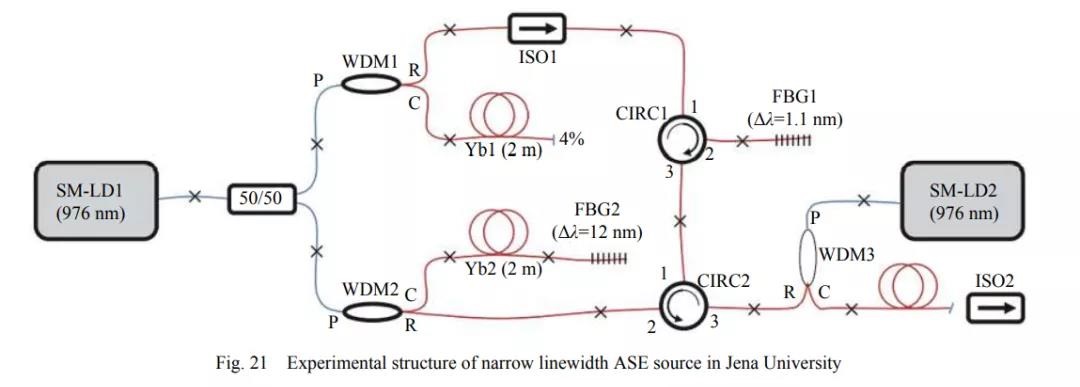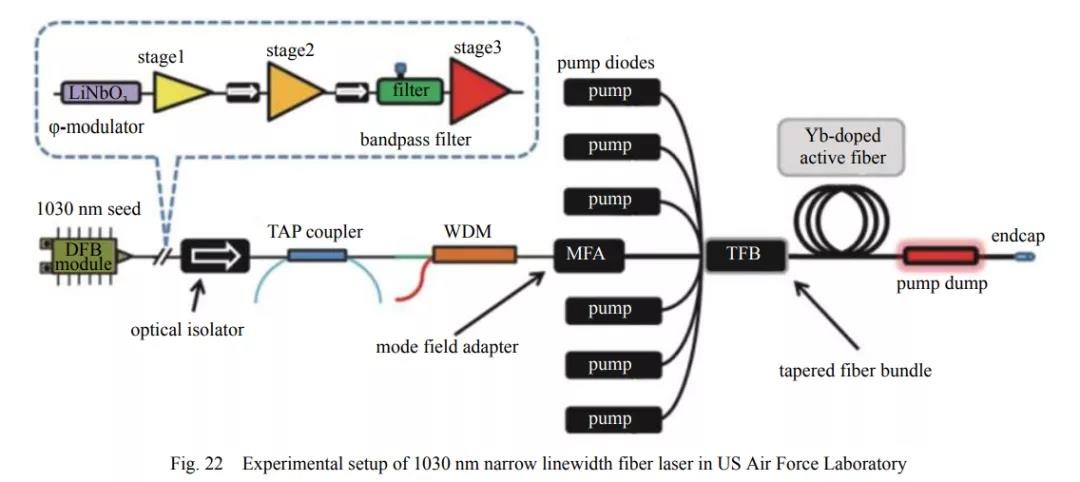
In 2011, O. Schmidt of the University of Jena used a narrow linewidth ASE source as the seed light for amplification. The seed source structure is shown in Figure 21. Two gratings are used to control the seed linewidth at 12 pm, the seed output power is 400 mW, and the center wavelength is 1030 nm. The seed source is amplified in two stages. The first stage uses a 40/200 photonic crystal fiber and the second stage uses a 42/500 photonic crystal fiber. The final output power is 697 W and the beam quality is M2=1.34 [46].

In 2016, Nader A. Naderi of the U.S. Air Force Laboratory used a single-frequency laser with a PRBS signal modulated 1030 nm as a seed source. The seed source's spectral linewidth was 3.5 GHz, and then it was amplified by an amplifier stage. The experimental device is shown in Figure 22. . The system increases the laser output power of the 1030 nm band to 1034 W, the spectral linewidth is 11 pm, the output efficiency of the amplifier stage is 80%, the ASE suppression ratio is up to 40 dB, and the beam quality is M2 = 1.1 to 1.2. In the experiment, the SBS and ASE effects were suppressed by controlling the length of the gain fiber [47-48].

In 2014, Ye Huang et al. of Nufern Company in the United States achieved kw laser output in the wavelength range of 1028~1100 nm [49]. In the experiment, the 1028 nm and 1100 nm lasers were mainly studied, and the results were compared with the 1064 nm lasers. It was found that compared with the traditional band fiber lasers, the ASE effect of both short-wavelength and long-wavelength fiber lasers was significantly enhanced. Finally, after suppressing the ASE effect, a 1215 W single-mode laser output was achieved in the 1028 nm band, and the optical efficiency was 75%.

In 2016, American company Roman Yagodkin et al. performed phase modulation on a single-frequency laser as a seed source. After amplification, a laser output of >1.5 kW was obtained. The laser center wavelength range is 1030~1070 nm, and the spectral linewidth is <15 GHz[50]. The output spectrum at the wavelength is shown in Figure 23. It can be seen from the spectrum that the ASE suppression ratio of the short-wavelength laser spectrum is about 15 dB lower than that of the laser near 1064 nm. In 2017, the US IPG Company performed phase modulation on the 1030 nm single-frequency laser to expand the spectrum to 20 GHz. After a three-stage pre-amplification stage, the output power reached 15-20 W, and finally after the main amplifier stage, the output power was 2.2 kW. The short-wavelength laser output is currently the highest output power of the 1030 nm band fiber laser [50].
In summary, due to the influence of the ASE effect, the maximum output power of the short-wavelength narrow-linewidth fiber laser is only 2.2 kW, which has a lot of room for development compared with the narrow-linewidth fiber laser near the typical wavelength of 1064 nm.
Copyright @ 2020 Shenzhen Box Optronics Technology Co., Ltd. - China Fiber Optic Modules, Fiber Coupled Lasers Manufacturers, Laser Components Suppliers All Rights Reserved.